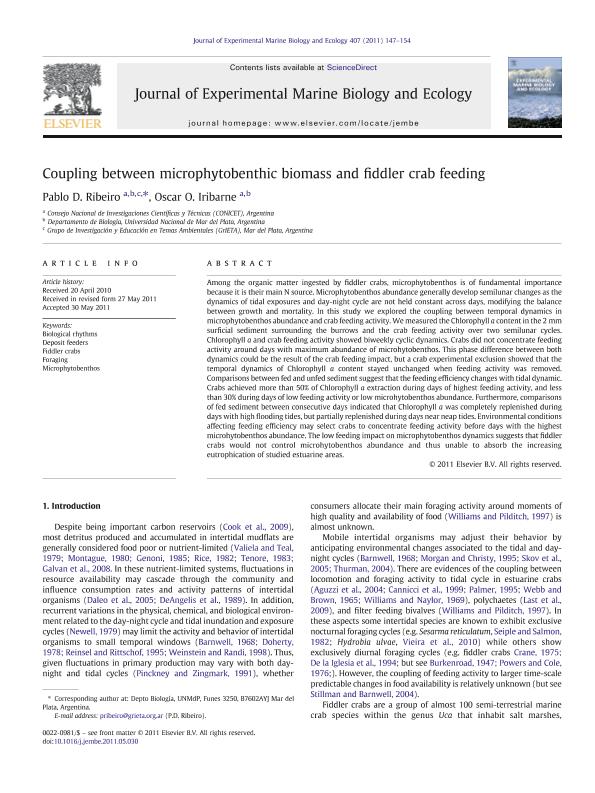Mostrar el registro sencillo del ítem
dc.contributor.author
Ribeiro, Pablo Damián

dc.contributor.author
Iribarne, Oscar Osvaldo

dc.date.available
2024-01-19T13:11:59Z
dc.date.issued
2011-10
dc.identifier.citation
Ribeiro, Pablo Damián; Iribarne, Oscar Osvaldo; Coupling between microphytobenthic biomass and fiddler crab feeding; Elsevier Science; Journal of Experimental Marine Biology and Ecology; 407; 2; 10-2011; 147-154
dc.identifier.issn
0022-0981
dc.identifier.uri
http://hdl.handle.net/11336/224259
dc.description.abstract
Among the organic matter ingested by fiddler crabs, microphytobenthos is of fundamental importance because it is their main N source. Microphytobenthos abundance generally develop semilunar changes as the dynamics of tidal exposures and day-night cycle are not held constant across days, modifying the balance between growth and mortality. In this study we explored the coupling between temporal dynamics in microphytobenthos abundance and crab feeding activity. We measured the Chlorophyll a content in the 2. mm surficial sediment surrounding the burrows and the crab feeding activity over two semilunar cycles. Chlorophyll a and crab feeding activity showed biweekly cyclic dynamics. Crabs did not concentrate feeding activity around days with maximum abundance of microhytobenthos. This phase difference between both dynamics could be the result of the crab feeding impact, but a crab experimental exclusion showed that the temporal dynamics of Chlorophyll a content stayed unchanged when feeding activity was removed. Comparisons between fed and unfed sediment suggest that the feeding efficiency changes with tidal dynamic. Crabs achieved more than 50% of Chlorophyll a extraction during days of highest feeding activity, and less than 30% during days of low feeding activity or low microhytobenthos abundance. Furthermore, comparisons of fed sediment between consecutive days indicated that Chlorophyll a was completely replenished during days with high flooding tides, but partially replenished during days near neap tides. Environmental conditions affecting feeding efficiency may select crabs to concentrate feeding activity before days with the highest microhytobenthos abundance. The low feeding impact on microphytobenthos dynamics suggests that fiddler crabs would not control microhytobenthos abundance and thus unable to absorb the increasing eutrophication of studied estuarine areas.
dc.format
application/pdf
dc.language.iso
eng
dc.publisher
Elsevier Science

dc.rights
info:eu-repo/semantics/openAccess
dc.rights.uri
https://creativecommons.org/licenses/by-nc-sa/2.5/ar/
dc.subject
BIOLOGICAL RHYTHMS
dc.subject
DEPOSIT FEEDERS
dc.subject
FIDDLER CRABS
dc.subject
FORAGING
dc.subject
MICROPHYTOBENTHOS
dc.subject.classification
Ecología

dc.subject.classification
Ciencias Biológicas

dc.subject.classification
CIENCIAS NATURALES Y EXACTAS

dc.title
Coupling between microphytobenthic biomass and fiddler crab feeding
dc.type
info:eu-repo/semantics/article
dc.type
info:ar-repo/semantics/artículo
dc.type
info:eu-repo/semantics/publishedVersion
dc.date.updated
2024-01-16T14:45:13Z
dc.journal.volume
407
dc.journal.number
2
dc.journal.pagination
147-154
dc.journal.pais
Países Bajos

dc.journal.ciudad
Amsterdam
dc.description.fil
Fil: Ribeiro, Pablo Damián. Consejo Nacional de Investigaciones Científicas y Técnicas. Centro Científico Tecnológico Conicet - Mar del Plata. Instituto de Investigaciones Marinas y Costeras. Universidad Nacional de Mar del Plata. Facultad de Ciencias Exactas y Naturales. Instituto de Investigaciones Marinas y Costeras; Argentina. Universidad Nacional de Mar del Plata. Facultad de Ciencias Exactas y Naturales. Departamento de Biología; Argentina
dc.description.fil
Fil: Iribarne, Oscar Osvaldo. Consejo Nacional de Investigaciones Científicas y Técnicas. Centro Científico Tecnológico Conicet - Mar del Plata; Argentina. Universidad Nacional de Mar del Plata. Facultad de Ciencias Exactas y Naturales. Departamento de Biología; Argentina
dc.journal.title
Journal of Experimental Marine Biology and Ecology

dc.relation.alternativeid
info:eu-repo/semantics/altIdentifier/url/http://www.sciencedirect.com/science/article/pii/S0022098111002450
dc.relation.alternativeid
info:eu-repo/semantics/altIdentifier/doi/https://doi.org/10.1016/j.jembe.2011.05.030
Archivos asociados
